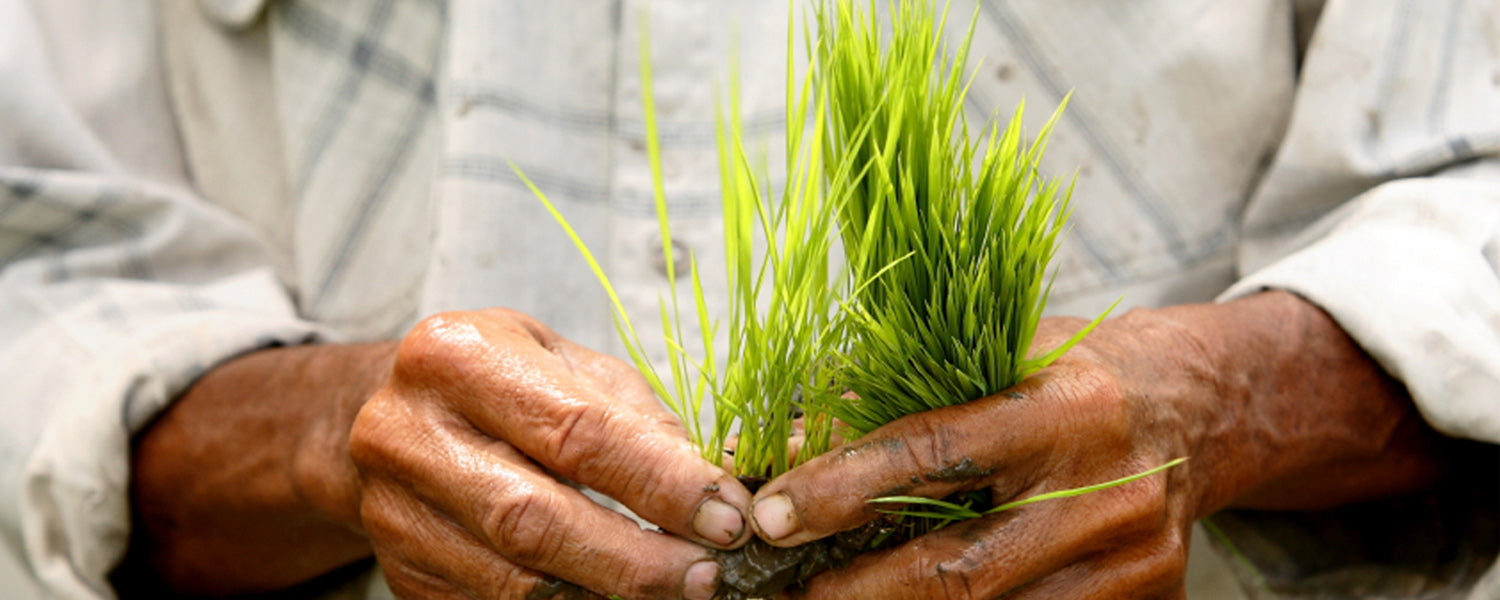Rice and its History
To See The World in A Grain of Rice…
 Rice is the staple food for more than three billion people all around the world. At least 114 countries grow rice and more than 50 have an annual production of 100,000 tons or more. Rice is the main food for most countries in Asia, while some countries in Africa and South America consume rice in comparable quantity as wheat and corn. Since a large portion of maize crops are grown for purposes other than human consumption, rice is probably the most important grain with regards to human nutrition and caloric intake, providing more than one fifth of the calories consumed worldwide by humans.
Rice is the staple food for more than three billion people all around the world. At least 114 countries grow rice and more than 50 have an annual production of 100,000 tons or more. Rice is the main food for most countries in Asia, while some countries in Africa and South America consume rice in comparable quantity as wheat and corn. Since a large portion of maize crops are grown for purposes other than human consumption, rice is probably the most important grain with regards to human nutrition and caloric intake, providing more than one fifth of the calories consumed worldwide by humans.
Rice Around the World
 Rice has fed more people over a longer period of time than any other crop. As far back as 2500 B.C, rice has been documented in the history books as a source. Beginning in China and the surrounding areas, its cultivation spread throughout Sri Lanka, and India. It was then passed onto Greece and areas of the Mediterranean. Rice spread throughout Southern Europe and to some of North Africa. From Europe rice was brought to the New World. From Portugal it was brought into Brazil and from Spain to Central and South America. Currently, there are about 120,000 varieties of rice grown all around the world.
Rice has fed more people over a longer period of time than any other crop. As far back as 2500 B.C, rice has been documented in the history books as a source. Beginning in China and the surrounding areas, its cultivation spread throughout Sri Lanka, and India. It was then passed onto Greece and areas of the Mediterranean. Rice spread throughout Southern Europe and to some of North Africa. From Europe rice was brought to the New World. From Portugal it was brought into Brazil and from Spain to Central and South America. Currently, there are about 120,000 varieties of rice grown all around the world.
Rice is intimately engrained in the culture many societies. In some Asian languages, the word 'eating' is actually synonymous with "eating rice". Rice is an integral part of myth and folklore, with storytelling conveying to younger generations the history and importance of rice
 Many folklores tell the origin of rice. For example, Myanmar folklore tells us that when the Kachins of northern ancient Burma were sent forth from the center of the Earth, they were given the seeds of rice and were directed to a wondrous country where everything was perfect and where rice grew well. In China, they believed that once a terrible flood destroyed the earth and all sources of food until a dog ran through the land giving everyone it passes rice seeds that hung from its tail. Once planted, it cured all hunger.
Many folklores tell the origin of rice. For example, Myanmar folklore tells us that when the Kachins of northern ancient Burma were sent forth from the center of the Earth, they were given the seeds of rice and were directed to a wondrous country where everything was perfect and where rice grew well. In China, they believed that once a terrible flood destroyed the earth and all sources of food until a dog ran through the land giving everyone it passes rice seeds that hung from its tail. Once planted, it cured all hunger.
Some cultures associate rice closely with their Gods. According to Shinto belief, the Emperor of Japan is the living embodiment of Ninigo-nomikoto, the god of the ripened rice plant. While most modern Japanese may intellectually dismiss this supernatural role, they cannot deny the enormous cultural importance of rice on life in their country - and so it is in much of the rice world.
The Importance of Rice in Indonesia
 Rice is Indonesia's the most important food crop with 238 million Indonesians simply love eating rice! They can eat rice three times a day for breakfast, lunch and dinner. With over 6.500 delicious local varieties, it is no wonder that Indonesia is the biggest rice consumer per capita in the world, with one person consuming 145 kg of rice in a year.
Rice is Indonesia's the most important food crop with 238 million Indonesians simply love eating rice! They can eat rice three times a day for breakfast, lunch and dinner. With over 6.500 delicious local varieties, it is no wonder that Indonesia is the biggest rice consumer per capita in the world, with one person consuming 145 kg of rice in a year.
Rice is synonymous livelihood in Indonesia. Indonesia is an agricultural nation with about 40 million farmers most depending on in the rice as their main crop. Rice also plays an important cultural role in Indonesia, symbolizing life and prosperity. Much of Indonesian history, mythology, and festivals, are centered around this precious staple. Indonesians worship Dewi Sri, the Indonesian Goddess of Rice, who is believed to have control over birth and life, and controls the rice fields and the growth of rice. In light of this, Dewi Sri controls the life, wealth and prosperity of Indonesia. Many ancient Javanese and Balinese Kingdoms paid outmost respect and present lavish offerings respect to Dewi Sri, ensuring that they continuously have good harvests. Plentiful rice equals to wealth and survival of their kingdoms.
Indonesians worship Dewi Sri, the Indonesian Goddess of Rice, who is believed to have control over birth and life, and controls the rice fields and the growth of rice. In light of this, Dewi Sri controls the life, wealth and prosperity of Indonesia. Many ancient Javanese and Balinese Kingdoms paid outmost respect and present lavish offerings respect to Dewi Sri, ensuring that they continuously have good harvests. Plentiful rice equals to wealth and survival of their kingdoms.
 Rice plays a crucial role in many cultural ceremonies. One famous Balinese festival, Galungan, is uses black rice that is especially planted with 13 blessings throughout its growth. This festival commemorates the victory of good (dharma) over evil (adharma) and is celebrated every 210 days and lasts for 10 days. As the expression of victory, people will fit penjor – a tall bamboo splendidly decorated with black rice, woven young coconut leaves, fruit, cakes and flowers, as offerings to God. This penjor is placed on the right side of every house entrance. People are attired in their finest clothes and jewels on that day as they believe that all the Gods will come down to earth during this period.
Rice plays a crucial role in many cultural ceremonies. One famous Balinese festival, Galungan, is uses black rice that is especially planted with 13 blessings throughout its growth. This festival commemorates the victory of good (dharma) over evil (adharma) and is celebrated every 210 days and lasts for 10 days. As the expression of victory, people will fit penjor – a tall bamboo splendidly decorated with black rice, woven young coconut leaves, fruit, cakes and flowers, as offerings to God. This penjor is placed on the right side of every house entrance. People are attired in their finest clothes and jewels on that day as they believe that all the Gods will come down to earth during this period.
 For Indonesians, rice is also a celebration of life. Nasi Tumpeng, or yellow rice, is traditionally served to celebrate special occasion, such as birthdays, marriages or even success at work. It is composed of rice flavored with coconut milk and turmeric to achieve a yellow tinge symbolizing wealth and high morals in the shape of a cone. The height of the cone symbolizes the greatness of God, and the traditional dishes surrounding the base of the cone, such as fried chicken, coconut beef stew, soyabean cake, beef jerky, shredded potato cakes, and chili paste, symbolize nature's abundance.
For Indonesians, rice is also a celebration of life. Nasi Tumpeng, or yellow rice, is traditionally served to celebrate special occasion, such as birthdays, marriages or even success at work. It is composed of rice flavored with coconut milk and turmeric to achieve a yellow tinge symbolizing wealth and high morals in the shape of a cone. The height of the cone symbolizes the greatness of God, and the traditional dishes surrounding the base of the cone, such as fried chicken, coconut beef stew, soyabean cake, beef jerky, shredded potato cakes, and chili paste, symbolize nature's abundance.
Fun Facts About Rice
*The age of rice is thousands of years old.
*1 kg of rice contains over 29,000 grains especially in long grain white rice.
*Rice is a sacred staple food where countries like Japan, where shrines are built for the God of Rice.
*When referring to the main rice field, the Japanese call it “Honda”.
* When referring to plentiful of rice, Japanese call it “Toyota”.
*A family gathering for a meal in Thailand is "Eating Rice"
* Rice is a greeting in China. When asked "have you had your rice today?" it is the Western equivalent of asking “how are you?”
*Rice in India is described as how two brothers should be thought of: close, and yet not sticky.
*Rice was used in an autograph by the musician and actor Louis Armstrong the musician and actor. It read "Red beans and Ricely yours..."

